How to eat buckwheat if you have type 1 diabetes
Buckwheat is one of the healthiest grain crops. It is indispensable for proper nutrition. Quickly and for a long time satiating, it replaces potatoes and bread in the daily diet of people with diabetes. There are no special contraindications to its use. Not only simple porridge is prepared from buckwheat, but also a variety of other dishes and drinks, recipes for which you will find in this article, and you will also find out whether buckwheat increases blood sugar and how to steam it correctly.
Chemical composition, trace elements and characteristics of buckwheat
The cereal contains a balanced complex of essential amino acids and minerals: magnesium, zinc, iodine, iron, potassium. Cereals are characterized by a high concentration of phytosterols, carbohydrates and purines.
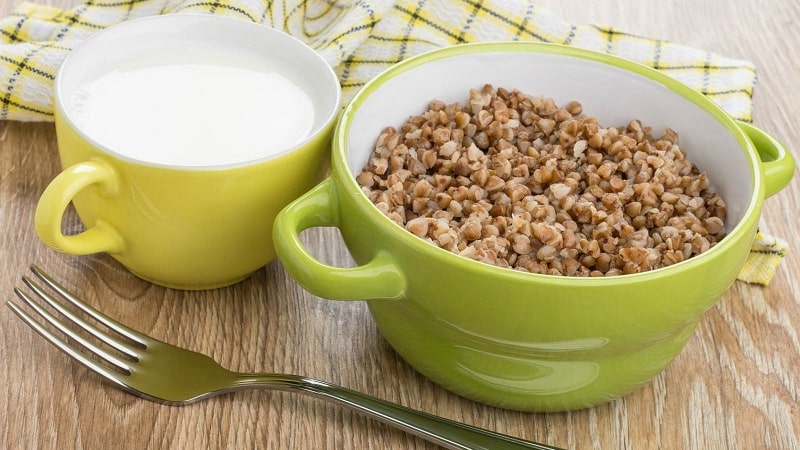
100 g of product contains:
- proteins – 11.73 g;
- fats – 2.71 g;
- carbohydrates – 74.95 g;
- calories – 343 g.
Glycemic index average – 50. Buckwheat dishes are safe even when consumed daily.
Attention! Salt and oil increase the calorie content of the product to 500 kcal per 100 g. Heat treatment does not reduce it.
Does buckwheat increase blood sugar?
The starch in buckwheat breaks down into glucose and increases blood sugar levels. But the high fiber content promotes slow absorption of nutrients, which does not cause a sharp jump in sugar levels. Therefore, buckwheat dishes in the diet are ideal for people with diagnosed diabetes.
Benefits and vitamins
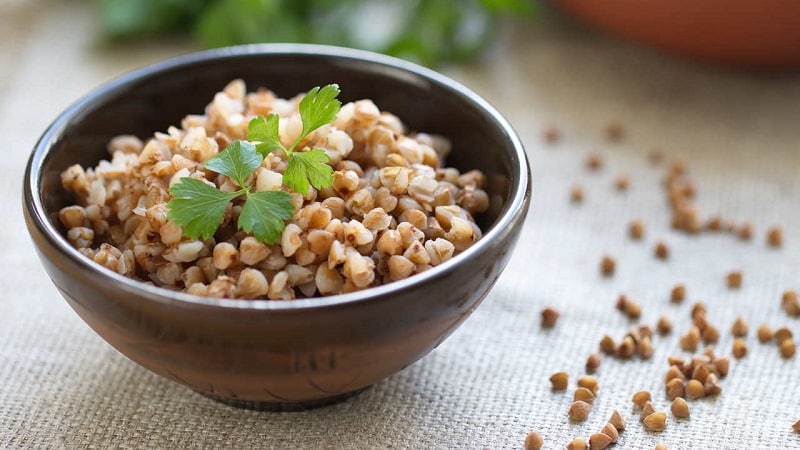
Cereals contain various vitamins (groups B, C, E, D, PP, K, U), as well as tocopherol, carotene, lutein, choline and biotin. This composition strengthens the cardiovascular system and immunity, reduces cholesterol levels in the blood, normalizes liver function, and promotes weight loss.
Is it possible to eat buckwheat if you have high sugar levels?
The buckwheat diet is popular among doctors. Its value lies in its ability to normalize metabolic processes in the body, as well as the minimum number of contraindications.
Benefit
Buckwheat is an environmentally friendly product, as it does not absorb pesticides used during cultivation. Nicotinic acid and manganese in the composition stimulate the production of insulin by the pancreas. This helps maintain the required amount of zinc in the body, as it is included in insulin molecules. Selenium strengthens the immune system and helps iron to be absorbed. All this makes buckwheat very useful for diabetes.
Reference. Manganese deficiency is one of the causes of diabetes mellitus.
Harm
Despite the fact that buckwheat is rich in vitamins, minerals and amino acids, in some cases it causes allergies. In case of individual intolerance, it can cause harm to the body.
Viscous buckwheat porridge, which is recommended by experts for diabetes, affects the gastrointestinal tract, causing constipation and heaviness in the stomach. If such symptoms appear during consumption, it is advisable to chop the kernel before cooking.
Buckwheat is also not recommended for flatulence - it provokes the active formation of gases and black bile. If you have increased stomach acidity, frequent diarrhea and kidney failure, it is not recommended to use buckwheat with kefir.
Rules for choosing, storing and consuming buckwheat for type 1 diabetes
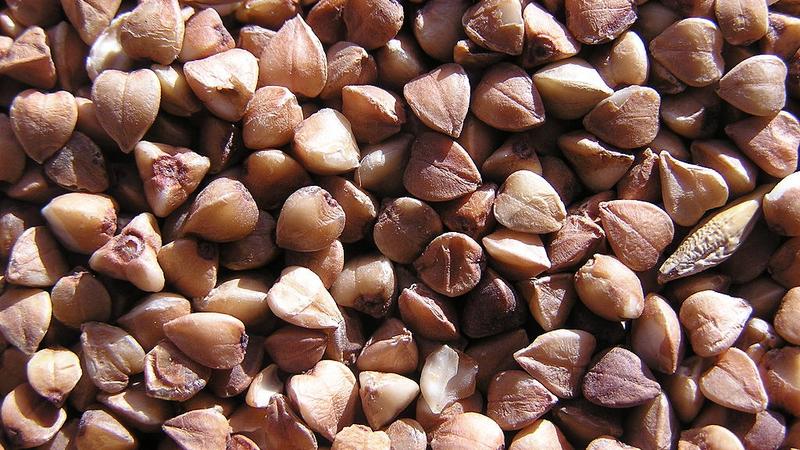
There is a wide selection of buckwheat on store shelves. A few simple rules allow you to make the right choice.
Criteria for choosing green and brown buckwheat
Green buckwheat very useful for diabetics, but more expensive than usual, has a short shelf life and a specific taste.
Reference. The natural color of buckwheat is yellowish-green. It becomes brown after heat treatment, during which a certain amount of useful substances is lost.
The package must not contain stems, husks, leaves or small pebbles. All this indicates the low quality of the product. Buckwheat grains are whole and of the same size.
Unlike brown grains, green buckwheat is suitable for germination and does not require heat treatment.
If the storage and preparation rules are not followed, mucus is formed, which causes gastrointestinal upset. Eating green buckwheat is not recommended for people with increased blood clotting, spleen diseases, gastritis, or under the age of 12 years.
Before reaching the store shelf, brown buckwheat undergoes heat treatment several times: it boilto get rid of the shell, and then fried. Re-cooking at home reduces the benefits by 30%.
When purchasing, pay attention to the grains: they should be the same shape, and there should be no particles of crushed grains in the packaging. Make sure that the production and packaging dates are printed on the packaging and not on a separate sticker, because it can easily be replaced with another one with new data. If you notice a musty odor when opening the package, the product must be returned to the store. Eating such buckwheat is dangerous to health.
Storage methods
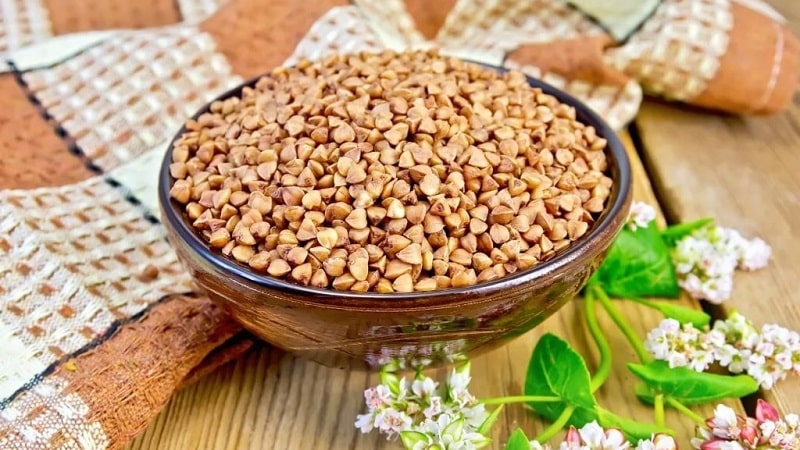
The rules for storing green and brown buckwheat are the same.It should be a cool, dark place and an airtight jar to prevent insects from entering. Place a paper or gauze bag with salt in the jar, which will act as a sorbent and prevent the cereal from getting damp. Additionally, add 1-2 bay leaves or garlic cloves. This will prevent the buckwheat from spoiling.
Experts do not advise stocking up on cereal for future use, as after 2 years the taste will deteriorate and mold will appear.
Use
Buckwheat is boiled, steamed or in the oven, and stewed with vegetables over low heat. Green buckwheat is sprouted.
Consumption rate
Large portions of buckwheat will cause a jump in blood sugar levels. Experts advise eating no more than 6 tbsp at one meal. l. prepared product. If you adhere to this simple rule, in case of type 1 diabetes, buckwheat will only benefit the body.
What do you eat buckwheat with if you have diabetes?
In addition to the usual porridge cooked in water, they make noodles, bake pancakes, cutlets, and even make drinks. Vegetables, fruits and kefir are added to the porridge unless there are specific contraindications.
Recipes with buckwheat for type 1 diabetes
For type 1 diabetes, buckwheat forms the basis of the diet. It is important to consult with your doctor to identify contraindications and select appropriate low-sugar products.
With kefir
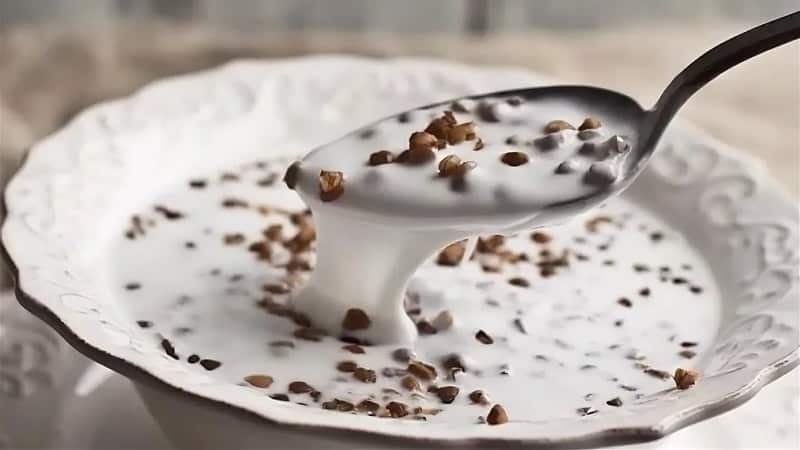
Preparation:
- 1 tbsp. l. Grind the cereal in a blender and pour in 200 ml of kefir or low-fat yogurt.
- Leave in the refrigerator for about 8-10 hours.
- The mixture is recommended to be consumed in the morning and evening. Evening intake - 4 hours before bedtime.
The maximum course of such a diet is 14 days. If abused, especially on an empty stomach, it can cause inflammation of the pancreas and liver.
Germination
Only green buckwheat is sprouted:
- Rinse the cereal with water and transfer to a glass container.
- Pour water until all the grains are completely covered and leave for 5-6 hours. Then drain the water and rinse the cereal.
- Pour the buckwheat again, but with warm water, cover the container with a lid or gauze.
- Turn the grains every 6 hours during the day.
- Rinse the buckwheat again before use.
Pancakes
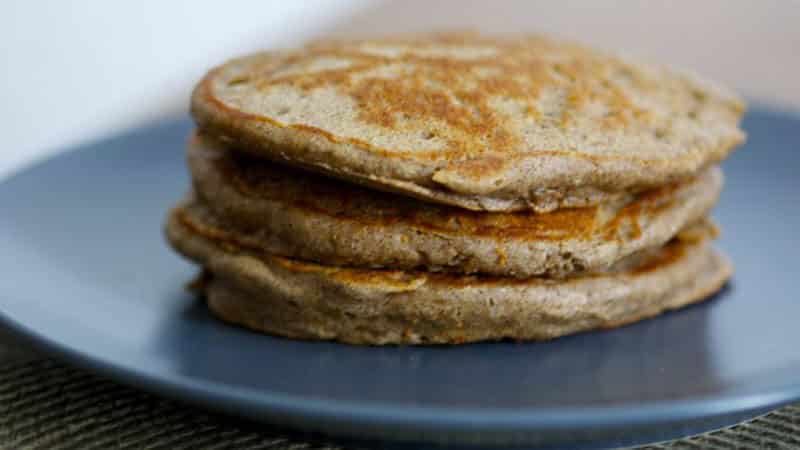
Suitable for breakfast and as a dessert.
Ingredients:
- 2 tbsp. cold buckwheat porridge;
- 2 chicken eggs;
- 0.5 tbsp. low-fat milk;
- 1 tbsp. l. honey;
- 1 tbsp. flour;
- 1 tsp. baking powder;
- 1 apple;
- 3 tbsp. l. vegetable oil.
Cooking method:
- Grind cold buckwheat porridge in a blender, add chopped apple and sunflower oil.
- Separately make a dough from eggs, milk, honey, flour and baking powder.
- Add a mixture of apples, buckwheat, sunflower oil to the dough and mix thoroughly.
- Bake in a dry frying pan.
Pilaf
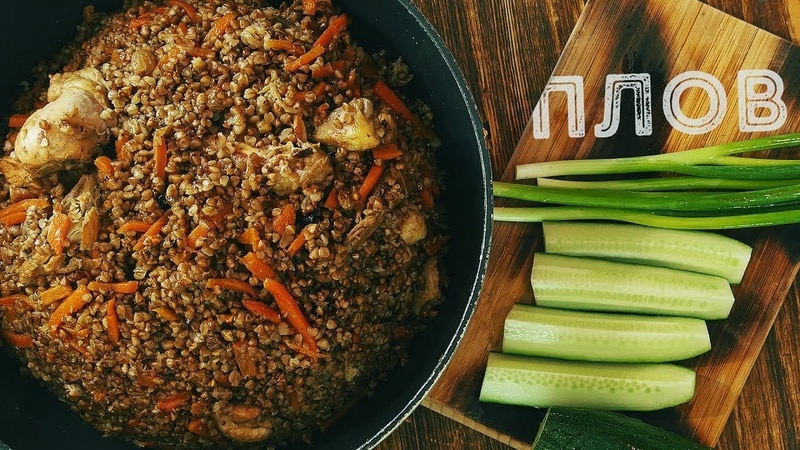
Cooking method:
- In a frying pan with a little water and without vegetable oil, simmer mushrooms, onions, carrots and garlic for 10 minutes.
- Add 1 tbsp. water, add 150 g of buckwheat, previously washed, add a little salt.
- Simmer for 20 minutes over medium heat, covered.
Soba (buckwheat noodles)
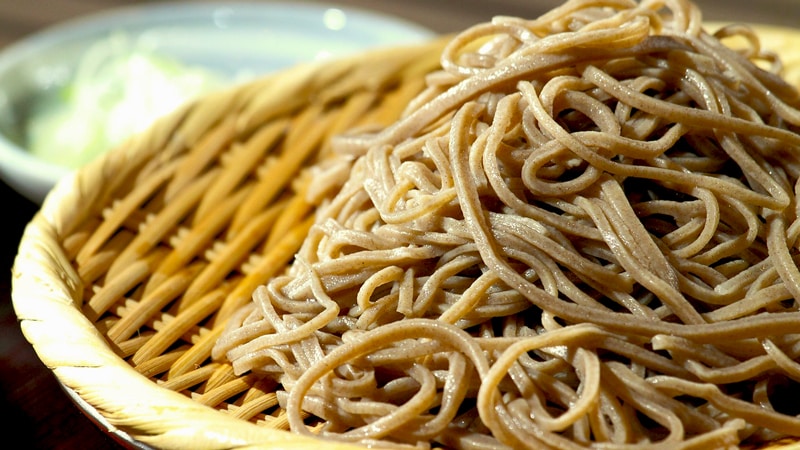
To prepare such noodles, buckwheat flour is used.
Ingredients:
- 500 g buckwheat flour;
- 200 g wheat flour;
- 1 tbsp. hot water.
If it is not possible to purchase ready-made buckwheat flour, grind the cereal and sift through a fine sieve.
Cooking method:
- From buckwheat and wheat flour, as well as 1 tbsp. water to knead the dough. The main inconvenience when kneading is the crumbliness and toughness of the dough.
- Roll it into a ball and divide it into several parts in the form of koloboks. Leave to “rest” for 30 minutes.
- Roll each ball into a thin layer, sprinkle with flour and cut into strips.
- Send to cook in salted boiling water until done.
Steamed cutlets
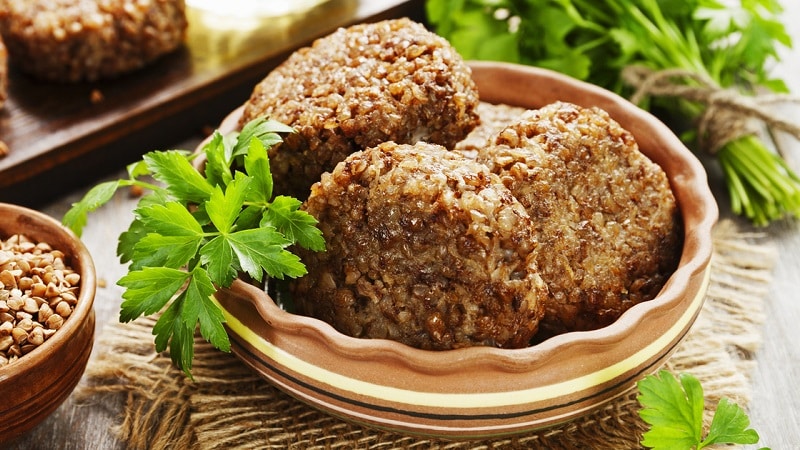
Ingredients:
- 100 g buckwheat flakes;
- 1 PC. raw potatoes;
- 1 clove of garlic;
- 1 onion (small).
Cooking method:
- Pour boiling water over buckwheat flakes for 5 minutes until you get a paste.
- Grind the potatoes and squeeze out the liquid. Let it sit so that the starch settles to the bottom. Then carefully drain the water.
- Add cereal porridge, potatoes, chopped onions and garlic, and salt to the starch. Mix.
- Form cutlets and steam.
Grechaniki with minced chicken
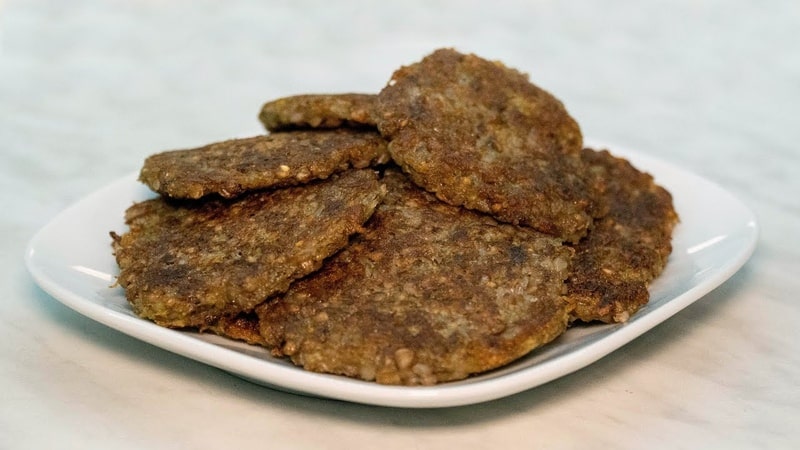
Ingredients:
- 200 g minced chicken;
- 100 g buckwheat;
- 1 egg;
- 1 small onion;
- 2 tbsp. l. flour;
- spices.
Cooking method:
- Boil buckwheat until tender.
- Mix minced meat, buckwheat, onion and egg until smooth. Form small cutlets.
- Dip in flour and steam.
Kissel
Cooking method:
- 3 tbsp. l. Grind buckwheat in a blender and dilute with 300 ml of water.
- Cook with constant stirring for 3-5 minutes.
- Leave the resulting jelly for 3 hours.
Eat buckwheat jelly 2 times a day 1 hour before meals.
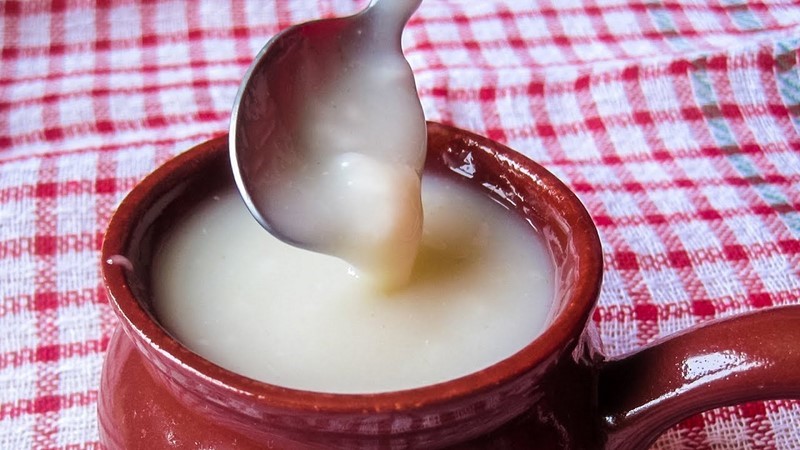
Infusion
Preparation:
- 2 tbsp. l. Pour the buckwheat with water and simmer for 1 hour in a water bath until the cereal is thoroughly cooked.
- Strain the mixture and cool.
Use ½ tbsp infusion. 2 times a day.
Conclusion
Properly prepared buckwheat lowers blood sugar levels, provides the body with vitamins and minerals, and also prevents the development of complications. A buckwheat-based diet strengthens the immune system and has a beneficial effect on the functioning of the endocrine system.But before using recipes, especially those based on green buckwheat, it is better to consult with your doctor.